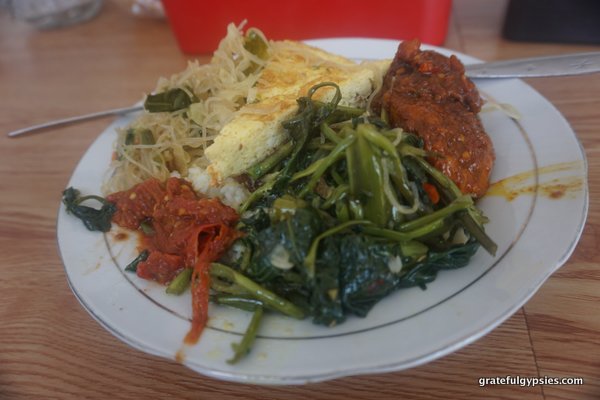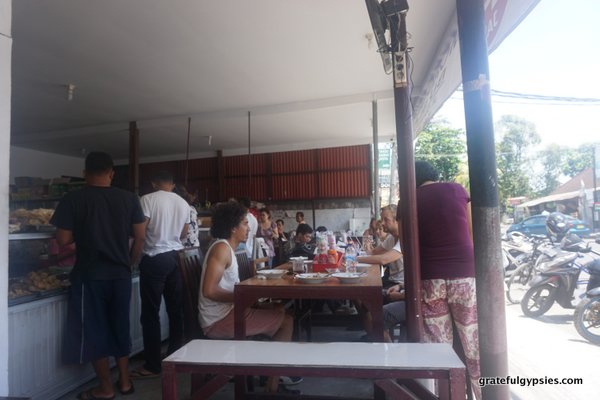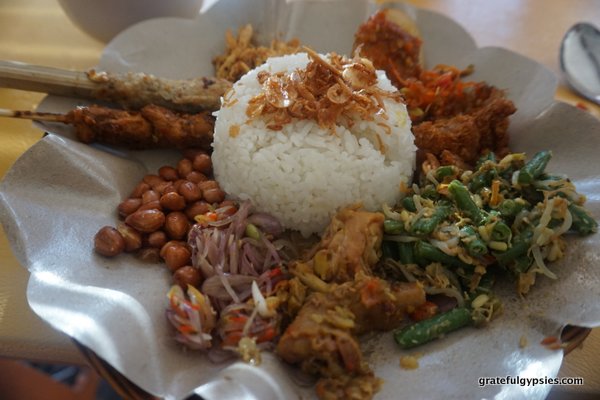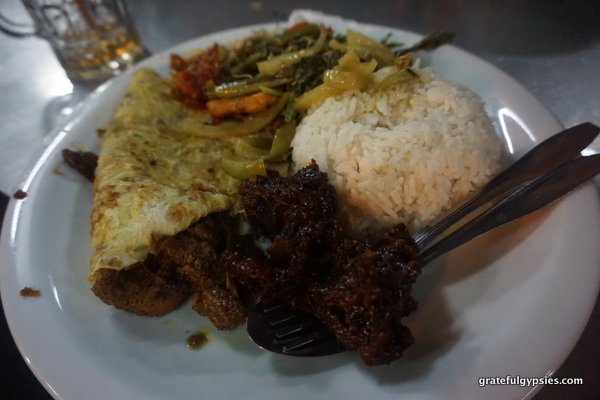Indonesian Food – Nasi Campur Posted by sasha on Dec 13, 2016 in Uncategorized
No matter where you are in the vast archipelago nation of Indonesia, there’s one item that’s constant on menus – nasi campur (mixed rice). Whether you’re traveling on Sumatra, Java, Bali, or any of the other thousands of islands, you’re sure to find this Indonesian classic. Let’s learn a bit about this Indonesian staple food, along with some useful vocabulary to help you make your order.
What is Nasi Campur?
Basically, you order up a plate of rice and choose from the wide variety of dishes that are on display. If you’re the kind of person who’s grossed out by food that’s sitting out, you might not be into nasi campur. In my experience traveling and living in Indonesia, I always found the food in these kind of places to be best at or around peak meal times. If you go there at 3 o’clock in the afternoon, you’re not going to have as many choices as you would at noon, and the food is likely to be a bit cold.
Anyways, you just browse the various dishes that are available and choose as many as you want. Once your plate is filled just the way you like it, the restaurant staff will survey your order and hand you a card with the price. Add some sambal (chili sauce) if you want and order up a drink such as es teh (ice tea) and you’ve got yourself a great meal. A typical plate of nasi campur with one or two meat/seafood dishes and veggies will only set you back 15-30,00 Rupiah, or about $1-2.50.
What’s On the Menu?
Depending on where you are in Indonesia, the items available for a nasi campur plate will differ. For example, you’ll find that pork is pretty common on Hindu Bali, but most certainly not in parts of Indonesia where the population is majority Muslim. In restaurants labeled as Masakan Padang (Padang cuisine) – a very common sight across the country – you’ll almost always see rendang sapi (beef rendang). No matter where you are, you’ll likely find a few chicken and fish dishes, quite a few choices for vegetables, and of course, an abundance of rice.
Nasi Campur Vocabulary
While you can always just get away with pointing and saying “ini” (this) or “itu” (that), it’s much better to learn a bit of Bahasa Warung (warung language). Get these words down and you should be able to confidently order your big plate of rice in Indonesian:
nasi = rice
-
nasi putih = white rice
-
nasi merah = brown rice (lit. red rice)
-
nasi kuning = yellow rice
-
nasi campur = mixed rice
daging = meat
-
ayam = chicken
-
sapi = beef
-
babi = pork
-
kambing = lamb/goat
-
bebek = duck
makanan laut = seafood
-
ikan = fish
-
lele = catfish
-
udang = shrimp
-
cumi-cumi = squid
-
ikan tuna = tuna
sayur = vegetables
-
cap cay = stir-fried vegetables
-
tahu = tofu
-
tempeh = tempeh
-
kentang = potato
-
sayur hijau = green vegetables
Misc.
-
mie = noodles
-
telur = egg
-
sambal = chili sauce
-
krupuk = crackers
-
saus kari = curry sauce
Useful Phrases
-
Saya mau… = I want…
-
Saya tidak makan… = I don’t eat…
-
Ini apa? = What’s this?
-
Berapa harganya…? = How much is…?
-
Enak sekali! = Very delicious!
I’m sure your mouth is watering by now, so get out there and put your new Indonesian skills to use to load up a big, tasty plate of nasi campur! The options are endless, so you could easily eat it every day and never get sick of it. It’s also always very affordable, so you can enjoy a delicious meal without breaking the bank. Selamat makan! (Bon appétit!).

Build vocabulary, practice pronunciation, and more with Transparent Language Online. Available anytime, anywhere, on any device.
About the Author: sasha
Sasha is an English teacher, writer, photographer, and videographer from the great state of Michigan. Upon graduating from Michigan State University, he moved to China and spent 5+ years living, working, studying, and traveling there. He also studied Indonesian Language & Culture in Bali for a year. He and his wife run the travel blog Grateful Gypsies, and they're currently trying the digital nomad lifestyle across Latin America.







